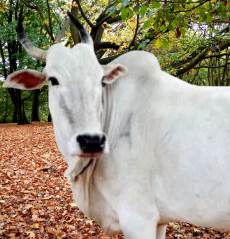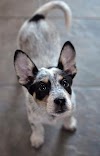The Amrit Mahal cow breed is native to the Karnataka state of Mysore. The Amrit Mahal appears majestic. They come from a cross between the Hallikar breed and the Hagalavadi and Chithradurg breeds. Amrit Mahal breed was developed in the middle of the 1800s by the former Mysore State's rulers. This particular breed was chosen because it is well suited to the climate and terrain of its native country. The bullocks were divided into categories such as pack bullocks, gun bullocks, etc. to transport military equipment. Amrit Mahal means "house of milk." They gained a significant deal of attention in the nineteenth century due to their durability and their ability to transport military supplies quickly. They are capable of completing a 100-mile march in two and a half days.
Amritmahal Cow Characteristics
The name Amritmahal refers to the "house of milk." It mostly comes in shades of grey, white, and almost black. Some cows exhibit distinct patterns of white-gray markings. Its features include a long, well-proportioned head, bloodshot eyes, small, tapering ears, a thin dewlap, a well-developed hump, a compact body, a muscular, relatively long neck, thin skin, and a shiny short hair coat. The average weight of the male is 500 kilograms, while the average weight of the female is 318 kilograms. The average length of a male's body is 134.1 centimeters, while a female's body is 126 centimeters. Its initial calving age is between 36 to 72 months.
The way these cattle have formed their heads and horns is their most distinctive feature. The forehead is furrowed and narrow at the center, with a little outward protrusion. The horns come out of the top of the poll, moving upward and backward in a somewhat tight pattern, and ending in sharp tips that are typically black.

The cattle exhibit a very impatient, wild, and unruly demeanor because they are kept in the pasture regions without any limits and handling. They are occasionally harmful, especially to strangers. They require patience and care when being trained; harsh treatment makes them resistant. After receiving proper training, they mature into very good bullocks, particularly those suited for rapid transportation. They are known for their endurance. Cows are inefficient milkers.
Amritmahal Cow Milk per day
These cows exhibit a lactation period that ranges from 210 to 310 days. This breed of cows produces little milk. The average amount of milk produced during lactation is 572kg. The milk contains an average milk fat content of 5.7%. The breed is primarily kept in Karnataka farms.
In the semiarid climate of India, the hardy Amritmahal cattle breed does well since it requires little roughage to maintain its health and milk production. The breed is recognized for its tough body and ability to travel great distances with minimal rest.
Bulls and cows of the Amritmahal breed range in height from 140 to 150 cm, making them medium-sized types of cattle. Amrit Mahal's cows are terrible milkers.
Amritmahal Cow Price
Amritmahal is an Indian draught breed that originated in Karnataka. They are closely connected to the Chitradurga cattle breed as well as the Hagalavadi cattle breed. They are utilized for the transportation of equipment due to their speed and durability. As a result of their low milk production, they are referred to as drought breeds. Amrit Mahal cows are normally grey with white-gray markings, ranging from practically white to nearly black.
The cost of the Amrit Mahal cow fluctuates widely based on several factors including its age, the amount of milk it produces, and whether or not it is currently lactating. A typical Amrit Mahal cow costs between INR 2 to 3 lakhs. The State also decided to provide older Amrit Mahal cows free of charge private cow-shelter (goshala) facilities.









0 Comments